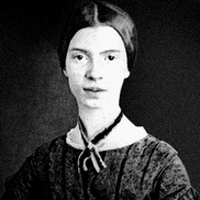I like to see it lap the Miles by Emily Dickinson: Summary and Analysis
The poem I like to see it lap the Miles was written in 1862 and was published for the first time in 1891. It was an age of rapid growth of technology. The Amherst and Belcher town Railway had already been established. The poem is a record of the poet's reaction of the coming of the train. Emily Dickinson invests the mechanical product of technology with aesthetic effects.

Emily Dickinson (1830-1886)
In this riddle like poem, Dickinson never mention the name of the subject, but referred to as 'it'. And it is about the train. She does not describe the thing, the Railway train itself. But she describes with a sense of wonder, the beauty of the locomotive, without ever mentioning it. In the poem Emily Dickinson presents the Railway train in the metaphor of a mythical horse. The metaphor is appropriate, because it suggests the superhuman power of the train. The poem also illustrates Emily Dickinson's habit of charging words with the new meanings. In its purpose, design and tone, the poem is remarkably similar to Whitman's "To a Locomotive in winter."
The speaker likes to gaze at the movement of the train, the way it laps the miles and licks the valleys up and how it stops to take water. Once it is filled with water, it then takes a prodigious step forward. The speaker appreciates the train's speed and power as it goes through valleys, stops for fuel, then "steps" around some mountains.
The train continues its journey and travels around a mountain range and then takes peeps with an air of contempt and superiority into the huts around the mountains. It then cuts and trims a distant quarry in the mountains. Between the sides of a quarry or a tunnel, the train claw's groaning and complaining in horrid hooting noise. Then finally it goes down the hill. The words 'crawl' and 'chase' add picturesqueness to the movement of the train. Till the end of the third stanza the train's movement and the distances it covered and the places it crossed are vividly presented. The train itself is portrayed not as a mere machine, but as a living being. This is only to prepare us to receive the final metaphor in the last stanza of the poem. The train now neighs like a mythical horse and then promptly comes to a stop at its stable door.
As the poem is framed as a riddle, the speaker does not mention the exact word for the description she uses in her poem. She is amazed by the development of transportation and the introduction of the train in her town for the first time. She likes to watch this strange creature which "lick the Valleys up", feeds itself, crawls and even shows its emotions by complaining and is very arrogant. She gives the qualities of the natural world of the animal to the train and juxtaposes between them. Though on the surface the poem seems to be praising the train, implicitly the speaker does not like it; her description of it as a “supercilious” is somehow negative. Further the sound of the train is presented in an undesirable way like “horrid” “hooting” and “complaining”. Its unwanted features are combined with its "omnipotent," power. It is not a good thing in the natural world as it goes on licking all the hills and destroying the peace of the town with its horrid sound. For the speaker, the new creature does not fit the natural world that is why, it might be one reason, she does not mention the word train in her poem.
Cite this Page!
Shrestha, Roma. "I like to see it lap the Miles by Emily Dickinson: Summary and Analysis." BachelorandMaster, 3 Dec. 2017, bachelorandmaster.com/britishandamericanpoetry/i-like-to-see-it-lap-the-miles-summary-analysis.html.
Related Topics
Much Madness is Divinest Sense: Analysis
Renunciation: Summary and Analysis
Because I could not Stop for Death: Analysis
I Heard a Fly Buzz: Summary and Analysis
After Great Pain, a Formal Feeling Comes: Analysis
Success is Counted Sweetest: Summary and Analysis
I taste a liquor never brewed: Summary and Analysis
A Bird came down the Walk: Summary and Analysis
Hope is the Thing with Feathers: Analysis
I had something that I called mine: Analysis
If I should Die: Summary and Analysis
I'm Nobody! Who are you?: Summary and Analysis
These are the days when the Birds come back
What Inn is this: Summary and Analysis
Exultation is the going: Summary and Analysis
Of Bronze-and Blaze: Summary and Analysis
A Clock Stopped: Summary and Analysis
I felt a Funeral, in my Brain: Summary and Analysis
Safe in their Alabaster Chambers: Analysis
There's a certain Slant of light: Summary and Analysis
To fight aloud, is very brave: Summary and Analysis
I like a look of Agony: Summary and Analysis
Bring me the sunset in a cup: Summary and Analysis
The day came slow-till Five o'clock: Analysis
 |
bachelorandmaster.com |